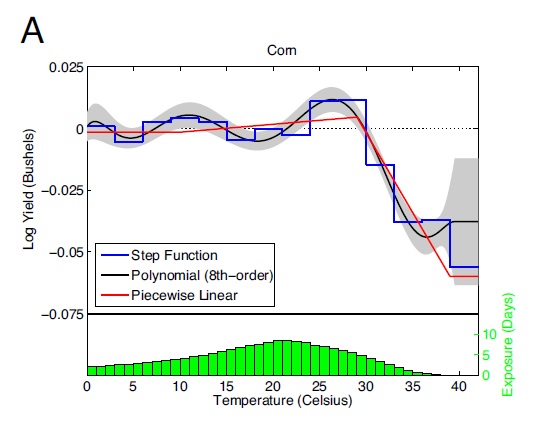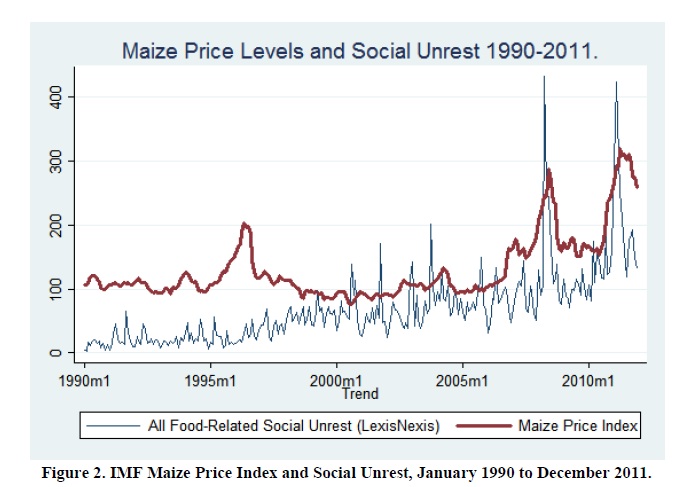I wish I’d had a chance to write on this topic earlier, but travel to the West Coast for work last week and working on my research this week prevented me from taking the necessary time to read everything I could find on food prices, digest it all, and write something worth reading on the topic.
The crop season started out nicely this spring, with corn producers setting out to cultivate almost 100 million of acres of corn, the largest cultivated area in 75 years. At the beginning of summer, however, things took a turn for the worst, with many areas experiencing both drought and extreme temperature.
Worry about Extreme Temperatures, Not Drought
Before anything else, I’d like to make one thing clear: Rather than drought, it looks as though it is extreme temperature that is the problem.
Indeed, according to my colleague Mike Roberts at NC State, drought is a poor predictor of crop yields, whereas extreme temperature — defined as the number of days for which temperature exceeds 84.2 degrees Fahrenheit — does a much better job of predicting crop yields.
The impact of temperature on crop yields looks like this (see the original research article here):

In other words, though there is a roughly linear relationship between temperature and corn yields from about 10 to about 29 degrees Celsius (i.e., from about 50 to about 84.2 degrees Fahrenheit), at which point corn yields drop sharply.
So What Can We Expect?
For American consumers, the price of food is expected to increase by 3 to 4 percent over the next year. Though this is bound to make some people worse off, it is not dramatic.
In 2010, the average US household spent 12.6 percent of its income on food, so if food prices increase by 4 percent, everything else equal, we can expect the average US household to spend 13.1 percent (i.e., 12.6 × 1.04) of its income on food next year — as I said, not dramatic. Food prices will not increase that much in the US because most of what we pay for food goes to labor and transportation costs.
For food-importing poor countries, however, we can expect something very different. Indeed, in my own research, I find statistical evidence that at the global level, rising food prices cause social unrest. Note that this is not merely a correlation — my work points to a causal relationship flowing from food prices to social unrest.
More specifically, I find that increases in the overall price of food, the price of cereals, and specific commodity prices (i.e., maize, rice, soybeans, and wheat) cause increases in the number of stories about social unrest in the media.
As regards corn (i.e., maize) prices specifically, here is a graph from my paper on the impacts of food prices on social unrest (though an old version of this paper is available, please email me for the most recent version):

Notice the two spikes on the right-hand side of the graph, which correspond to the food crises we experienced in late spring 2008 and in early 2011. On the basis of my research on the impacts of food prices on social unrest, I would not be surprised to witness an uptick in the number of food riots throughout the world later this summer.
And since some posit that food prices have sparked the Arab Spring, maybe we can expect this long, hot summer to have far-reaching geopolitical consequences.